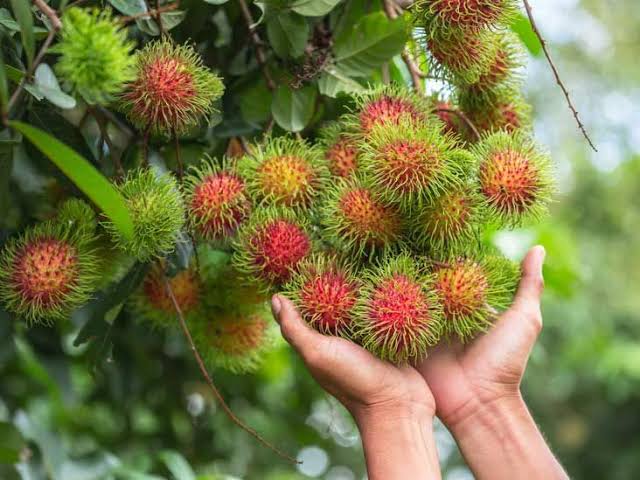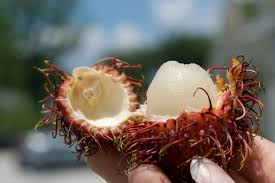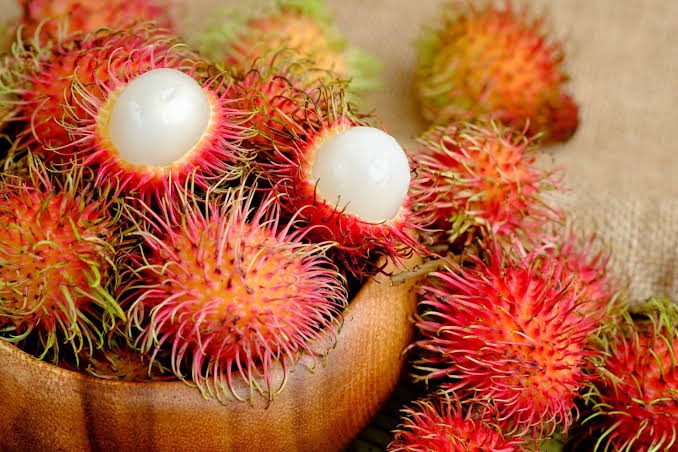Rambutans, scientifically known as Nephelium lappaceum, are fascinating tropical fruits that captivate with their unique appearance and delectable taste. Originating from Southeast Asia, these exotic fruits belong to the Sapindaceae family, closely related to lychees and longans.
With a distinctive outer skin covered in soft, hair-like spines, the name “rambutan” actually derives from the Malay word “rambut,” which translates to “hair.” This characteristic outer layer encases a translucent, juicy flesh that varies from white to pale pink or red, depending on the rambutan’s ripeness.
The flavor profile of a rambutan is a delightful combination of sweet and slightly acidic notes, making it a popular choice for those seeking a refreshing tropical treat. The fruit’s aromatic qualities further contribute to its appeal, as the sweet fragrance wafts through the air when the rambutans are ripe and ready to be enjoyed.
Rambutans are not only known for their delicious taste but also for their nutritional benefits. Rich in vitamin C, antioxidants, and minerals, these fruits offer a boost to the immune system and contribute to overall well-being. Additionally, rambutans contain natural sugars, providing a quick energy source for those indulging in their sweetness.
Cultivation of rambutans involves tropical climates, where they thrive in well-drained soils and warm temperatures. These trees, reaching up to 20 meters in height, produce clusters of the distinctive fruits. The harvesting season varies depending on the region, with some areas experiencing a single annual harvest, while others may have multiple harvests throughout the year.
In various cultures, rambutans hold symbolic significance. In Southeast Asia, they are often associated with good fortune and prosperity. The fruit is not only enjoyed fresh but is also used in culinary creations, such as jams, jellies, and desserts. The versatility of rambutans extends beyond their use in the kitchen, as their vibrant appearance adds aesthetic appeal to fruit baskets and tropical displays.
Despite their popularity in their native regions, rambutans have also gained recognition on a global scale, finding their way into international markets. As more people discover the delightful combination of taste and visual appeal that rambutans offer, their presence continues to expand, becoming a sought-after addition to fruit assortments worldwide.
Additionally, rambutans, scientifically identified as Nephelium lappaceum, are not just fruits; they are a sensory delight that engages the senses with their unique appearance, sweet aroma, and refreshing taste. Originating from Southeast Asia, these tropical gems bring a touch of exoticism to culinary creations and fruit displays across the globe, leaving a lasting impression on those fortunate enough to savor their delectable qualities.
Read Also: Cow’s Milk: Economic Benefits and Uses
The History of Rambutans Fruits

The history of rambutans traces back to the tropical regions of Southeast Asia, where these unique fruits have been cultivated and enjoyed for centuries. Belonging to the Sapindaceae family, the rambutan, scientifically known as Nephelium lappaceum, shares its botanical roots with lychees and longans.
The cultivation and consumption of rambutans date back to ancient times, with historical records suggesting that these fruits were enjoyed by indigenous communities in Malaysia, Indonesia, Thailand, and other neighboring countries. Over the years, rambutans became not only a staple in local diets but also an integral part of cultural traditions and practices.
The name “rambutan” itself has its origins in the Malay language, where “rambut” means “hair.” This nomenclature aptly describes the fruit’s distinctive outer appearance, characterized by a hairy or spiky rind. The evolution of the rambutan’s cultivation and propagation spread across Southeast Asia, adapting to diverse climates and soils conducive to its growth.
Rambutans were not only valued for their taste but also embraced for their symbolic significance in various cultures. In Southeast Asia, the fruit is often associated with good fortune, prosperity, and festive occasions. It became a common sight in traditional ceremonies and celebrations, reflecting the cultural importance attached to this tropical delicacy.
As trade routes expanded and global exploration increased, rambutans found their way beyond their native regions. The fruit gained recognition and popularity in international markets, contributing to its status as an exotic and sought-after addition to fruit assortments worldwide.
Today, rambutan cultivation extends beyond Southeast Asia, with plantations in tropical regions around the globe. Improved transportation and distribution methods have facilitated the export of fresh rambutans to diverse markets, introducing this tropical gem to new audiences.
The history of rambutans is a testament to the fruit’s enduring appeal, blending cultural significance with sensory delight. From its humble origins in Southeast Asia to its global recognition, the journey of rambutans reflects the interconnectedness of cultures and the appreciation for the diversity of the natural world. As these unique fruits continue to captivate palates worldwide, their history remains intertwined with the rich tapestry of tropical traditions and global exploration.
The Nutritional Values of Rambutans Fruits

Rambutans, beyond their enticing taste and unique appearance, offer a range of nutritional benefits. Here’s a breakdown of their nutritional values:
1. Calories: Rambutans are relatively low in calories, making them a guilt-free and satisfying snack. A serving size typically provides around 68 calories, making them a sensible choice for those watching their calorie intake.
2. Carbohydrates: The primary macronutrient in rambutans is carbohydrates. A serving usually contains about 16.5 grams of carbohydrates, contributing to the fruit’s sweet taste. The carbohydrates include natural sugars, such as fructose and glucose.
3. Protein: While not a significant source of protein, rambutans still contribute a small amount. A serving generally provides around 0.9 grams of protein.
4. Fat: Rambutans are low in fat, with a serving containing minimal amounts, usually less than 0.2 grams. This makes them a healthy choice for those aiming to reduce their fat intake.
5. Fiber: Rambutans are a good source of dietary fiber, promoting digestive health. A serving typically provides around 0.9 grams of fiber, aiding in digestion and contributing to a feeling of fullness.
6. Vitamin C: One of the standout nutritional aspects of rambutans is their high vitamin C content. A serving can offer up to 20 milligrams of vitamin C, contributing to immune system support, collagen formation, and antioxidant protection.
7. Antioxidants: Rambutans contain various antioxidants, including carotenoids and polyphenols. These compounds help combat oxidative stress in the body, potentially reducing the risk of chronic diseases.
8. Minerals: Rambutans provide small amounts of essential minerals, such as potassium, iron, magnesium, and phosphorus. These minerals play crucial roles in maintaining overall health, including proper heart function and bone health.
Incorporating rambutans into a balanced diet can contribute to overall well-being, providing a delicious way to enjoy essential nutrients. Whether eaten fresh or included in culinary creations, rambutans offer a tasty and nutritious addition to a diverse and healthy diet.
Read Also: The Reproductive Rate of Sheep and Goat
Health Benefits of Rambutans Fruits

Rambutans offer various health benefits, making them a valuable addition to a well-balanced diet. Here are some of the health benefits associated with consuming rambutans:
1. Rich in Antioxidants: Rambutans are packed with antioxidants, including carotenoids and polyphenols. These compounds help neutralize free radicals in the body, potentially reducing oxidative stress and lowering the risk of chronic diseases.
2. Boosts Immune System: The high vitamin C content in rambutans plays a crucial role in supporting the immune system. Vitamin C is known for its immune-boosting properties, aiding in the production of white blood cells and promoting a healthy immune response.
3. Aids Digestive Health: Rambutans are a good source of dietary fiber, which promotes digestive health. Fiber helps regulate bowel movements, prevent constipation, and support a healthy digestive system.
4. Energy Boost: The natural sugars, including fructose and glucose, in rambutans provide a quick and natural energy boost. This makes them an excellent choice for a snack, especially during periods of increased physical activity.
5. Hydration: Rambutans have a high water content, contributing to hydration. Staying well-hydrated is essential for various bodily functions, including temperature regulation, joint lubrication, and nutrient transport.
6. Contributes to Heart Health: The potassium content in rambutans is beneficial for heart health. Potassium helps regulate blood pressure, reducing the risk of hypertension and cardiovascular diseases.
7. Supports Skin Health: The combination of antioxidants and vitamin C in rambutans can contribute to healthier skin. These nutrients play a role in collagen formation, promoting skin elasticity and reducing signs of aging.
8. Provides Essential Minerals: Rambutans contain essential minerals such as iron, magnesium, and phosphorus, which play vital roles in maintaining overall health. Iron is crucial for preventing anemia, while magnesium and phosphorus contribute to bone health.
9. May Have Anti-Inflammatory Properties: Some studies suggest that the antioxidants in rambutans may have anti-inflammatory effects. Chronic inflammation is linked to various health issues, so including anti-inflammatory foods in the diet can be beneficial.
Incorporating rambutans into a diverse and nutritious diet can contribute to overall well-being. However, it’s important to enjoy them as part of a balanced lifestyle, complemented by other fruits, vegetables, and whole foods. As with any food, moderation is key to reaping the maximum health benefits.
How to Grow Rambutans Fruits (Growing Guide)
Growing rambutans can be a rewarding experience, especially if you live in a tropical or subtropical region. Here’s a general guide to help you cultivate these exotic fruits:
1. Climate: Rambutans thrive in tropical climates with high humidity and temperatures ranging between 68°F to 95°F (20°C to 35°C). They are sensitive to cold temperatures and can be damaged by frost.
2. Soil: Plant rambutans in well-draining soil with a slightly acidic to neutral pH level (around 5.5 to 7.5). Sandy loam or loamy soil is ideal.
3. Planting: Choose a sunny location for planting, ensuring the tree receives full sunlight. Plant rambutan seeds or seedlings in holes that are twice the diameter of the root ball. Space multiple trees at least 30 feet apart.
4. Watering: Rambutans require consistent moisture, especially during dry periods. However, they are susceptible to waterlogged conditions, so well-draining soil is crucial. Water the trees regularly, providing enough moisture to keep the soil consistently moist but not waterlogged.
5. Fertilization: Use a balanced fertilizer with micronutrients to promote healthy growth.
Fertilize rambutans three times a year – in early spring, midsummer, and early fall.
6. Pruning: Prune the tree to maintain its shape, remove dead or diseased branches, and improve air circulation. Pruning can also encourage better fruit production and make it easier to harvest.
7. Mulching: Apply a layer of organic mulch around the base of the tree to help retain soil moisture, suppress weeds, and provide some nutrients as it decomposes.
8. Pest and Disease Control: Keep an eye out for common pests like aphids and scale insects. Use insecticidal soap or neem oil to control infestations. Fungal diseases can occur, so proper spacing, good air circulation, and well-draining soil help prevent such issues.
9. Harvesting: Rambutans typically mature 3 to 5 months after flowering. The fruit is ready for harvest when the spines turn from green to yellow or red. Harvest by cutting the fruit stalk with sharp pruning shears, leaving a small portion attached to the fruit.
10. Post-Harvest: Rambutans are best enjoyed fresh, but they can be stored in the refrigerator for a few days. However, their flavor and texture are optimal when consumed shortly after harvesting.
Growing rambutans requires some patience, as these trees can take several years to mature and produce fruit. Additionally, local climate conditions and specific rambutan varieties may influence cultivation practices, so it’s advisable to consult with local horticultural experts for region-specific guidance.
